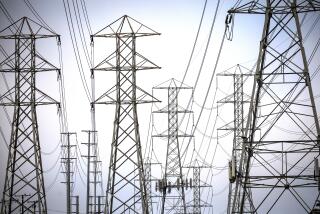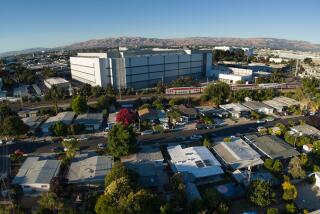Drought cuts power production of California dams
- Share via
Shasta Dam, looming more than 600 feet tall and gatekeeper of the largest man-made lake in California, was designed to perform two crucial functions: Store water and generate power.
And for decades, the massive concrete structure has channeled water to cities and farms while generating up to 710 megawatts of hydropower, enough to provide electricity for more than 532,000 homes.
But amid four years of drought, the reservoir is drained to 50% of capacity, cutting the dam’s power production by about a third, according to federal reclamation officials.
The story is the same at many dams across California, where electricity production at some is expected to be less than 20% of normal because of low water levels.
The shortfall shouldn’t cause brownouts, officials said, because California relies on dams for power far less than it did in decades past, due in part to the emergence of solar and wind energy.
But it does come at a price.
Hydropower, even with its diminished profile, is important to California’s energy mix as a quick, reliable and inexpensive source of electricity — a buffer during moments of peak demand.
A reduced supply from dams forces the grid operator to turn to more expensive sources of power, such as natural gas, which also enlarges the state’s carbon footprint.
“Consumers have paid more than a billion dollars more for electricity than they otherwise would’ve. And our greenhouse gas emissions are higher than they would otherwise have been,” said Peter Gleick, president of the Pacific Institute, an environmental think tank based in Oakland. “Over the last three years, and continuing this year, the costs are going to continue.”
In the 1950s, hydropower supplied almost 60% of the state’s electricity. Now, it provides 14% to 19% in a normal year, and even less during a drought — accounting for about 8% of the state’s total power last year. Renewable energy, on the other hand, provided more than 20%, according to the California Energy Commission.
Making up the difference from less hydropower has not been cheap. The cost to California ratepayers could have been as high as $1.4 billion from 2012 through 2014, according to a report by the Pacific Institute.
Renewable energy, especially solar, helped make up for about 55% of the reduction in hydroelectricity in 2013 and 2014, state officials said. Natural-gas-fired power made up the rest.
Burning more natural gas to compensate for the reduced hydropower led to an 8% increase in carbon dioxide emissions from California power plants during a three year period, said Gleick, author of the Pacific Institute study. Hydropower produces little to no air pollution.
“If the drought continues,” Gleick said, “if one of the impacts is a permanent reduction in hydropower, we need to ramp up other renewables even more than we are.”
Experts said California had little choice but to diversify its power generation beyond dams.
Even in normal years, the dams have been producing basically the same amount of hydropower as they did decades ago. Huge population growth since the 1950s meant the need for more overall electricity. Instead of building more dams to supply the extra electricity, officials found other sources of energy.
“We’ve built on all of the good dam sites in California. We’re not going to expand hydrogeneration almost anywhere in the West,” Gleick said. “So in an expanding energy demand situation, hydro just becomes a smaller and smaller fraction of the overall system.”
When hydropower plants were first built in California a century ago, they were sold as a way to handle two precious commodities: power and water. In 1909, while creating the Los Angeles Aqueduct, officials began building hydroelectricity plants that helped power the construction equipment.
Hydropower is created when water passes through a turbine, which spins a generator and creates an electrical field. The power is sent to an electrical substation and enters the electric grid. Generating the power does not require extra water — After going through the turbines, usually in a power plant at a dam, the water returns to the river or canal system.
Unlike solar or wind-produced power, which depend on whether the sun comes out or the wind is blowing, hydropower is more controllable, officials said. At reservoirs, officials can turn a valve to increase the water flow whenever more electricity is needed. Energy suppliers rely on hydro as reserve power, and as a quick way to respond to surges in demand for electricity.
In drought years, it’s a difficult balancing act because hydropower isn’t always an immediate option.
“It’s a much bigger operational challenge,” said Colin Cushnie, Southern California Edison’s vice president of energy procurement and management. “The hydro energy plays a very important role in maintaining system reliability, because of the flexibility it provides system operators.”
Edison’s hydropower plants are expected to produce less than one-fifth of its usual production this year, but this will not affect Edison’s ability to keep the lights on for its 14 million customers, Cushnie said. Even in an average year, the hydropower Edison produces is only 5% of its total energy supply.
When hydropower is not as available, Edison has to rely more on natural-gas-fired power plants, which take longer to turn on and are more complicated to operate, Cushnie said. Wind and solar, and power purchased from other providers, have also helped Edison make up the hydropower difference.
Across the state, the continuing drought could also hit some electric customers in their wallets. One megawatt-hour of hydropower usually costs less than $1.40, while solar and wind could cost as much as $4.20 to $8.10 per megawatt-hour in the state, officials estimated.
The Sacramento Municipal Utility District, whose energy supply is about 20% hydroelectricity, began charging a 1.3% hydropower surcharge in April, or about $1.19 extra per month on an average residential bill. During dry years, the district has had a reserve fund to draw money to purchase extra power. In 2011, there was $40 million in the reserve. Four drought years later: Almost zero.
For the Sacramento Municipal Utility District, hydroelectricity is the bread and butter of power because it’s a highly effective system that was built 50 years ago. Officials don’t have to take bond money to build big new infrastructure, as they do for solar and wind power. To produce hydropower, it’s just maintenance and operation costs, spokesman Christopher Capra said.
Officials said costs will go down and there will be less reliance on natural gas to make up the difference as solar and wind power continue to grow. Wind and solar, accelerated by state mandates to focus on using renewable energy, have gone up more than 2.5 times in the past two years, said Robert Weisenmiller, chair of the California Energy Commission.
Wind and solar will also get cheaper and more reliable as more plants are installed, officials said.
But until this happens. Californians will have to stay drought-conscious, even when it comes to energy. Although it takes water to make electricity, it also takes electricity to move water from reservoirs to California’s farms and showers.
“Saving water and saving energy are tied together,” Weisenmiller said. “You can help save water by reducing energy use. It’s really important that going forward, we use both energy and water wisely.”
Twitter: @rosannaxia
More to Read
Sign up for Essential California
The most important California stories and recommendations in your inbox every morning.
You may occasionally receive promotional content from the Los Angeles Times.











